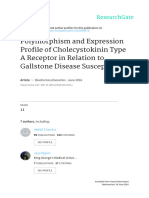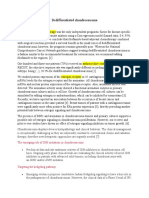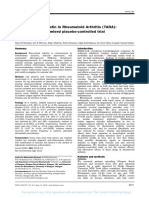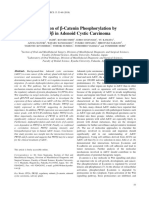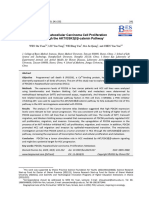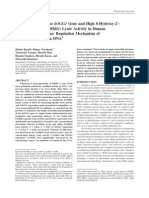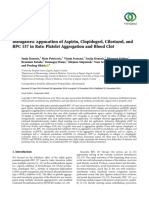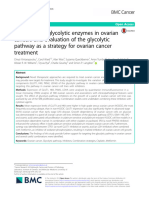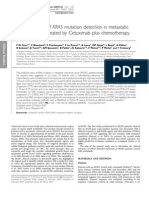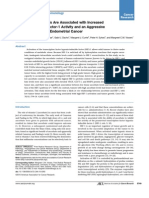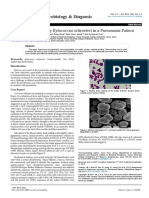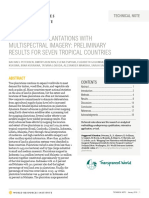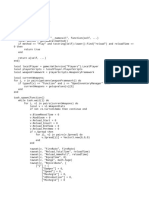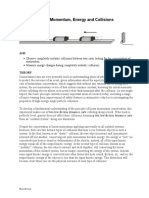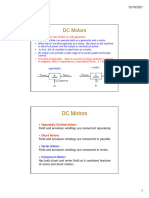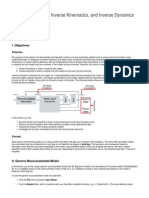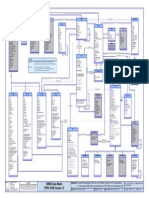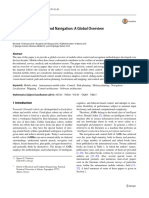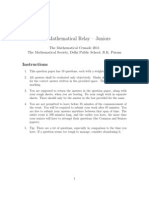Haubner J. NucI. Med. 2001, 42, 326-336
Haubner J. NucI. Med. 2001, 42, 326-336
Uploaded by
Samir AcherarCopyright:
Available Formats
Haubner J. NucI. Med. 2001, 42, 326-336
Haubner J. NucI. Med. 2001, 42, 326-336
Uploaded by
Samir AcherarCopyright
Available Formats
Share this document
Did you find this document useful?
Is this content inappropriate?
Copyright:
Available Formats
Haubner J. NucI. Med. 2001, 42, 326-336
Haubner J. NucI. Med. 2001, 42, 326-336
Uploaded by
Samir AcherarCopyright:
Available Formats
Downloaded from jnm.snmjournals.org by on February 23, 2018. For personal use only.
Glycosylated RGD-Containing Peptides: Tracer
for Tumor Targeting and Angiogenesis Imaging
with Improved Biokinetics
Roland Haubner, Hans-Jürgen Wester, Fred Burkhart, Reingard Senekowitsch-Schmidtke, Wolfgang Weber,
Simon L. Goodman, Horst Kessler, and Markus Schwaiger
Department of Nuclear Medicine and Institute of Organic Chemistry and Biochemistry, Technische Universität München, Munich;
and Department of Preclinical Oncology, Merck KGaA, Darmstadt, Germany
confirmed by the first gamma-camera images of osteosarcoma-
The ␣V3 integrin plays an important role in metastasis and tumor- bearing mice at 240 min postinjection. Conclusion: This study
induced angiogenesis. Targeting with radiolabeled ligands of the demonstrates that the introduction of a sugar moiety improves
␣V3 integrin may provide information about the receptor status the pharmakokinetic behavior of a hydrophobic peptide-based
and enable specific therapeutic planning. Previous studies from tracer. Additionally, this ␣V3-selective glycosylated radioiodi-
our group resulted in tracers that showed ␣V3-selective tumor nated second-generation tracer GP2 shows high tumor uptake
uptake. However, these first-generation compounds predomi- and good tumor-to-organ ratios that allow noninvasive visual-
nantly revealed hepatobiliary excretion with high radioactivity ization of ␣V3-expressing tumors and monitoring therapy with
found in the liver. In this report, the synthesis and biological eval- ␣V3 antagonists. Finally, the favorable biokinetics make the
uation of the first glycosylated RGD-containing peptide (RGD- glycosylated RGD-peptide a promising lead structure for tracers
peptide) for the noninvasive imaging of ␣V3 expression are de- to quantify the ␣V3 expression using PET.
scribed. Methods: Peptides were assembled on a solid support Key Words: glycosylated RGD-peptides; ␣V3 antagonists; in-
using fluorenylmethoxycarbonyl-coupling protocols. The precur- tegrin; angiogenesis; tumor targeting
sor cyclo(-Arg-Gly-Asp-D-Tyr-Lys(SAA)-) GP1 was synthesized by
coupling 3-acetamido-2,6-anhydro-4,5,7-tri-O-benzyl-3-deoxy-- J Nucl Med 2001; 42:326 –336
D-glycero-D-gulo-heptonic acid (SAA(Bn3)) with cyclo(-Arg(Mtr)-
Gly-Asp(OtBu)-D-Tyr(tBu)-Lys-) and subsequent removal of the
protection groups. Iodine labeling was performed by the Iodo-
Gen method (radiochemical yield ⬎ 50%). The in vitro binding
assays were performed using purified immobilized ␣IIb3, ␣V5,
C ell matrix interactions are fundamental to tumor inva-
sion and formation of metastases (1) as well as to tumor-
and ␣V3 integrins. For in vivo experiments, nude mice bearing
xenotransplanted melanomas and mice with osteosarcomas induced angiogenesis (2). The integrins, heterodimeric
were used. Results: The glycosylated peptide 3-iodo-Tyr4- transmembrane glycoproteins that compose a diverse family
cyclo(-Arg-Gly-Asp-D-Tyr-Lys(SAA)-) GP2 showed high affinity of 19 ␣ and eight  subunits, play a key role in these
and selectivity for ␣V3 in vitro (50% inhibitory concentration ⫽ interactions (3). In addition to adhesive functions, it is
40 nmol/L). Pretreatment studies indicate specific binding of
increasingly apparent that integrins transduce messages by
[125I]GP2 on ␣V3-expressing tumors in vivo. Comparison of the
pharmacokinetics of [125I]GP2 and [125I]-3-iodo-Tyr4-cyclo(-Arg- classical signaling pathways and may influence proliferation
Gly-Asp-D-Tyr-Val-) [125I]P2 revealed for [125I]GP2 an increased and apoptosis of tumor cells as well as activated endothelial
activity concentration in the blood (e.g., 3.59 ⫾ 0.35 percentage cells (2,4).
injected dose [%ID]/g vs. 1.72 ⫾ 0.44 %ID/g at 10 min postin- An integrin with a well-characterized involvement in
jection) and a significantly reduced uptake in the liver (e.g.,
angiogenesis (5) and tumor invasiveness (6) is ␣V3. This
2.59 ⫾ 0.24 %ID/g vs. 21.96 ⫾ 2.78 %ID/g at 10 min postin-
jection). Furthermore, a clearly increased activity accumulation
integrin is expressed on various malignant human tumors
in the tumor was found (e.g., 3.05 ⫾ 0.31 %ID/g vs. 0.92 ⫾ 0.16 (6) as well as on endothelial cells during neovascularization
%ID/g at 240 min postinjection), which remained almost con- (2,7). Inhibition of the ␣V3-mediated cell-matrix interac-
stant between 60 and 240 min postinjection. This resulted in tion leads to apoptosis of activated endothelial cells and
good tumor-to-organ ratios for the glycosylated tracer (e.g., disrupts blood vessel formation (8). By contrast, ␣V3 is not
240-min postinjection osteosarcoma model: tumor-to-blood ⫽
strongly expressed on quiescent endothelial cells. Thus,
16; tumor-to-muscle ⫽ 7; tumor-to-liver ⫽ 2.5), which were
treatment with ␣V3 antagonists did not affect preexisting
blood vessels (9). In tumor models, inhibition of blood
Received Apr. 27, 2000; revision accepted Aug. 14, 2000. vessel formation using ␣V3 antagonists not only blocked
For correspondence and reprints contact: Roland Haubner, PhD, Depart- tumor-associated angiogenesis but in some cases resulted in
ment of Nuclear Medicine, Klinikum rechts der Isar, Technische Universität
München, Ismaninger Strasse 22, D-81675 Munich, Germany. tumor regression (8,10).
326 THE JOURNAL OF NUCLEAR MEDICINE • Vol. 42 • No. 2 • February 2001
Downloaded from jnm.snmjournals.org by on February 23, 2018. For personal use only.
These encouraging experimental studies have already led to 4 mm) (YMC Co., Ltd., Kyoto, Japan). For radioactivity measure-
initial clinical trials evaluating the use of ␣V3 antagonists as ments, the outlet of the ultraviolet detector was connected to a well
antiangiogenic drugs in patients with various malignant tumors scintillation NaI(Tl) detector from EG & G (Munich, Germany).
(11). However, currently available imaging techniques are For analytical data, several acetonitrile-water gradients with 0.1%
trifluoroacetic acid (TFA) were used.
limited in monitoring treatment with this class of drug. Anti-
Preparative RP-HPLC was performed with the Sykam HPLC
tumor activity is generally assessed by determining the per- system. Columns were YMC-Pack ODS-A (5 m, 250 ⫻ 30 mm)
centage of patients in whom a significant reduction of the for the reference peptides and precursor and YMC-Pack ODS-A (5
tumor size is achieved during a relatively short period of m, 250 ⫻ 4 mm) for radioactively labeled compounds with the
therapy (“response rate”). Thus, this method may not be ap- same solvent system as described above.
plicable for a form of therapy that is aimed at disease stabili-
Synthesis of the Sugar Amino Acids
zation and prevention of metastases. Therefore, noninvasive
Synthesis of 3-Acetamido-2,6-Anhydro-4,5,7-Tri-O-Benzyl-3-
methods to visualize and quantify ␣V3 expression in vivo Deoxy--D-Glycero-D-Gulo-Heptonic Acid. The benyzl-protected
appear to be crucial for the future development and clinical sugar amino acid 3-acetamido-2,6-anhydro-4,5,7-tri-O-benzyl-3-
application of ␣V3 antagonists in cancer patients (11). Using deoxy--D-glycero-D-gulo-heptonic acid (SAA(Bn3)) was synthe-
these techniques, it would be possible to determine ␣V3- sized according to Hoffmann et al. (13).
dependent angiogenesis and to recognize those patients most Synthesis of 3-Acetamido-2,6-Anhydro-3-Deoxy--D-Glycero-D-
amenable to this kind of therapy. Gulo-Heptonic Acid. SAA(Bn3) (0.2 mmol) was dissolved in 3.5
We have recently described radiolabeled cyclic RGD- mL of a mixture of tetrahydrofuran/methanol (MeOH)/water (3:3:
peptides with high affinity and selectivity for the ␣V3 1). After addition of 0.57 mmol palladium oxide and 200 L acetic
integrin (12). These peptides showed receptor-specific ac- acid (HOAc), the suspension was stirred for 48 h under a hydrogen
cumulation in different tumor and mouse models. However, atmosphere at ambient temperature. The suspension was filtered,
and the solvent was removed in vacuo. The crude product was
they also revealed fast hepatobiliary excretion. The result-
freeze-dried with tert.butanol (tBu). The sugar amino acid was
ing high activity concentration in the liver and intestine used without further purification. Deprotection was monitored with
limits the application of these tracers for tumor imaging. RP-HPLC and NMR.
The aim of this study was to improve the pharmacokinetics
of these ␣V3-selective, first-generation tracers to allow non- Peptide and Glycopeptide Synthesis
invasive imaging of ␣V3 expression with gamma camera Synthesis of Cyclic Pentapeptides. Loading of the TCP-resin,
synthesis of the peptides, and subsequent cyclization were per-
imaging techniques. For this purpose, glycosylation of a mod-
formed by protocols described elsewhere (12). Side chains were
ified derivative of these peptides by using a sugar amino acid protected with 4-methoxy-2,3,6-trimethylbenzenesulfonyl (Mtr) or
was evaluated to decrease lipophilicity and hepatic uptake. 2,2,4,6,7-pentamethyldihydrobenzofuran-5-sulfonyl (Pbf) for argi-
nine, benzyloxycarbonyl (Z), or 1-(4,4-dimethyl-2,6-dioxocyclo-
MATERIALS AND METHODS
hex-1-ylidene)ethyl for lysine and tBu for aspartic acid and ty-
All chemicals were used as supplied without further purifica- rosine. Because of the sensitivity of the D-3-iodo-tyrosine to
tion. 9-Fluorenylmethoxycarbonyl (Fmoc) amino acids were pur- reducing conditions using hydrogen or palladium, two different
chased from Bachem (Heidelberg, Germany) or Novabiochem synthesis routes for the reference peptide and the labeling precur-
(San Diego, CA). Synthesis of Fmoc-3-iodo-D-Tyr-OH was de- sor have been introduced. The resulting peptides are cyclo(-Arg-
scribed elsewhere (12). The tritylchloride polystyrol (TCP) resin (Mtr)-Gly-Asp(OtBu)-D-Tyr(tBu)-Lys(Z)-) (peptide precursor for
was purchased form PepChem (Tübingen, Germany). 1-Hydroxy- labeling) and cyclo(-Arg(Pbf)-Gly-Asp(OtBu)-D-3-iodo-Tyr-Lys-
benzotriazol (HOBt), O-(1H-benzo-triazol-1-yl)-N,N,N⬘,N⬘-tetra- (Dde)-) (peptide precursor for the reference compound).
methyluronium tetrafluoroborate, and diphenyl phosphorazidate Selective Removal of Z-Protection Group. Cyclo(-Arg(Mtr)-
were purchased from Aldrich (Steinheim, Germany) or Alexis Gly-Asp(OtBu)-D-Tyr(tBu)-Lys(Z)-) (1.3 mmol) was dissolved in
(Grünberg, Germany). 1-Hydroxy-7-azabenzotriazole (HOAt) and 20 mL dimethyl acetamide, and 400 L HOAc and 1 g palladium
O-(7-azabenzotriazol-1-yl)-1,1,3,3-tetramethyluronium hexafluoro- catalyst (5% Pd on charcoal) were added. The reaction mixture
phosphate were purchased from PerSeptive Biosystems (Hamburg, was allowed to stir under hydrogen atmosphere for 6 h at ambient
Germany). Sodium iodide-125 and sodium iodide-123 were pur- temperature. The solvent was reduced in vacuo, the residue was
chased from Amersham (Buckinghamshire, UK). All other organic resuspended in MeOH, and the suspension was filtered. The sol-
reagents were purchased from Merck (Darmstadt, Germany), vent was reduced, and the residue was triturated with ethyl ether,
Aldrich or Fluka (St. Louis, MO). filtered, and washed three times with ethyl ether. The peptide was
Mass spectra were recorded on the liquid-chromatography used without further purification. Analytical data were as follows:
mass-spectrometry system LCQ from Finnigan (Bremen, Ger- electrospray ionization mass spectrometry (ESI-MS): (M⫹H)⫹ ⫽
many) using the Hewlett-Packard series 1100 high-performance 944; RP-HPLC: retention time (tR) ⫽ 20.3 min and K⬘ ⫽ 4.8
liquid chromatography system. Nuclear magnetic resonance (30%– 80% MeCN; 30 min).
(NMR) spectra were recorded on a Bruker AC 250 or Bruker Selective Removal of Dde Protection Group. Cyclo(-Arg(Pbf)-
AMX 500 (Karlsruhe, Germany) at 300 K. For all experiments, the Gly-Asp(OtBu)-D-3-iodo-Tyr-Lys(Dde)-) (0.2 mmol) was dis-
solvent signal was used for calibration. solved in 50 mL 2% hydrazine in dimethylformamide (DMF) and
Analytical reversed-phase high performance liquid chromatog- stirred for 30 min at ambient temperature. The solvent was re-
raphy (RP-HPLC) was performed on Sykam equipment (Gilching, moved in vacuo, and the residue was triturated with water. The
Germany) using columns with YMC-Pack ODS-A (5 m, 250 ⫻ precipitated peptide was isolated using a Varifuge 3.2S (Heraeus;
GLYCOSYLATED RGD-CONTAINING PEPTIDES • Haubner et al. 327
Downloaded from jnm.snmjournals.org by on February 23, 2018. For personal use only.
TABLE 1
Analytical Data of Cyclic Peptides*
MW‡ ESI-MS tR
No. Peptide† (g/mol) (M ⫹ H)⫹ (min) K⬘ Log P§
P1 c(RGDyV) 590.64 591 13.0 4.9
P2 c(RGD(I)yV) 716.53 717 21.2 8.6 ⫺1.89
P3 c(RGDfY) 638.68 639 19.1 7.7
P4 c(RGDf(I)Y) 764.58 765 24.7 10.2 ⫺1.16
GP1 c(RGDyK(SAA)) 850.88 851 9.1 3.1
GP2 c(RGD(I)yK(SAA)) 976.26 977 15.5 6.0 ⫺2.45
*HPLC conditions: 10% MeCN with 0.1% TFA, 5 min; 10%–50% MeCN with 0.1% TFA, 30 min.
†Upper- and lowercase letters are used to distinguish between L- and D-amino acids in one-letter code for amino acids.
‡MW, molecular mass.
§Determined using 125I-labeled derivatives.
Munich, Germany). Analytical data were as follows: ESI-MS, follows: ESI-MS, (M⫹H)⫹ ⫽ 1285; RP-HPLC, tR ⫽ 17.5 min;
(M⫹H)⫹ ⫽ 1054; RP-HPLC, tR ⫽ 14.1 min and K⬘ ⫽ 4.4 and K⬘ ⫽ 5.5 (30%– 80% MeCN; 30 min).
(30%– 80% MeCN; 30 min). Removal of Side Chain Protection Groups of Peptides. Pep-
Synthesis of Cyclo(-Arg(Mtr)-Gly-Asp(OtBu)-D-Tyr(tBu)-Lys- tides were treated with 20 mL of a solution of 95% TFA, 2.5% water,
(SAA(Bn3))-). Cyclo(-Arg(Mtr)-Gly-Asp(OtBu)-D-Tyr(tBu)-Lys-) and 2.5% triisobutylsilane for 24 h at ambient temperature. The
(0.11 mmol) and 0.15 mmol of SAA(Bn3) were dissolved in 7 mL mixture was filtered if necessary, evaporated in vacuo, triturated with
DMF. To the combined solutions, two equivalents of 1-ethyl-3- ethyl ether, filtered again, and washed several times with ethyl ether.
(3⬘-dimethylaminopropyl)carbodiimide hydrochloride (EDCI ⫻ Removal of Benzyl Groups of Cyclo(-Arg-Gly-Asp-D-Tyr-Lys-
HCl) and two equivalents of HOBt were added. N-Ethylmorpho- (SAA(Bn3))-). The glycopeptide (47 mol) was dissolved in 10 mL
line was used to adjust the pH to approximately 7.5. After the water/HOAc (1:1). After adding 50 mg 5% Pd on charcoal, the
solution was stirred for 12 h at ambient temperature, the solvent reaction mixture was stirred under hydrogen atmosphere at ambi-
was reduced in vacuo, the residue was triturated with water, and ent temperature for 12 h. The catalyst was removed by filtration,
the crude peptide was isolated by centrifugation. Analytical data and toluene was added before removing the solvent in vacuo. The
were as follows: ESI-MS, (M⫹H)⫹ ⫽ 1445; RP-HPLC, tR ⫽ 29.1 crude product was freeze-dried. Analytical data were as follows:
min and K⬘ ⫽ 11.7 (30%–100% MeCN; 30 min). ESI-MS, (M⫹H)⫹ ⫽ 851; RP-HPLC, tR ⫽ 9.1 min; and K⬘ ⫽ 2.6
Synthesis of Cyclo(-Arg(Pbf)-Gly-Asp(OtBu)-D-3-Iodo-Tyr-Lys- (10%–50% MeCN; 30 min).
(SAA)-). Cyclo(-Arg(Pbf)-Gly-Asp(OtBu)-D-3-iodo-Tyr-Lys-) (14 The crude cyclic peptides and glycopeptides were purified by
mol) and 28 mol SAA were dissolved in 1 mL DMF. After RP-HPLC. Analytical data, including 1H- and 13C-chemical shift
addition of 28 mol of HOAt and 28 mol of HATU, the pH was data for GP1, are given in Tables 1 and 2.
adjusted to pH 8 using diisopropylethylamine. The solution was
allowed to stir for 70 h at ambient temperature. The solvent was Radioiodination
reduced in vacuo, and the crude glycopeptide was precipitated with The peptides cyclo(-Arg-Gly-Asp-D-Phe-Tyr-) P1 (12), cyclo(-
water and separated by centrifugation. Analytical data were as Arg-Gly-Asp-D-Tyr-Val-) P3 (12), and cyclo(-Arg-Gly-Asp-D-
TABLE 2
1H- and 13C-Chemical Shift Data of GP1 in DMSO-d6 at 300 K
1H-shift 13C-shift
Amino
acid*† HN H␣/H␣⬘ H/H⬘ H␥/H␥⬘ H␦/H␦⬘ Others C␣ C C␥ C␦ CO Others
Arg1 7.64 4.14 1.49/1.71 1.37 3.10 7.48 (HN⑀) 51.8 28.3 25.3 40.2 171.1 156.6 (guanidino C)
Gly2 8.30 3.22/4.02 43.2 169.4
Asp3 8.02 4.63 2.37/2.70 48.8 35.0 169.8 171.5 (COOH)
D-Tyr4 7.89 4.37 2.69/2.81 6.62; 6.92 (aromatic Hs) 54.5 36.6 170.8 129.9; 114.6; 127.3
(aromatic Cs)
Lys5 7.98 3.92 1.41/1.54 1.06 1.31 2.95 (H⑀), 7.75 (HN) 54.6 31.0 22.7 28.5 172.0 38.0 (C⑀)
*Sugar amino acid 1H-shift data: H1, 3.56; H2, 3.62; H3, 3.31; H4, 3.18; H5, 3.10; H6, 3.67; H6⬘, 3.50; HN, 7.66; and CO-CH3, 1.76.
†Sugar amino acid 13C-shift data: CO, 168.3; C1, 77.9; C2, 53.5; C3, 74.8; C4, 69.8; C5, 80.2; C6, 60.7; CO-CH , 169.4; CO-CH , 22.8.
3 3
Calibration was performed with reference to residual dimethyl sulfoxide signal (1H, 2.49 ppm; 13C, 39.5 ppm). Assignment of all proton
and carbon resonances followed standard methods (26).
328 THE JOURNAL OF NUCLEAR MEDICINE • Vol. 42 • No. 2 • February 2001
Downloaded from jnm.snmjournals.org by on February 23, 2018. For personal use only.
Tyr-Lys(SAA)-) GP1 were labeled with 125I or 123I (the last only Biodistribution Studies. Nude mice bearing tumor xenografts of
for GP1) using the IODO-GEN method. The peptides (0.3– 0.5 human melanoma M21 and BALB/c mice bearing murine osteo-
mol) were dissolved in 200 L of phosphate-buffered saline sarcomas were injected intravenously with 300 – 400 kBq [125I]P2,
(PBS) (pH 7.4). The solutions were added to Eppendorf caps [125I]P4, or [125I]GP2. Injections into the tail vein were accom-
coated with 150 g IODO-GEN and combined with 5–10 L plished under short-time ether anesthesia.
no-carrier-added (NCA) [125I]NaI (30 – 80 MBq) or 25 L carrier- The animals were killed and dissected at 10, 60, 120, and 240
added (CA) [123I]NaI (185 MBq). After 30 min at ambient tem- min after injection of the 125I-labeled peptides. Blood, plasma,
perature, the solutions were removed from the solid oxidizing liver, kidney, muscle, heart, brain, lung, spleen, intestine, thyroid,
reagent. Purification was performed using RP-HPLC. Radiochem- and tumor tissues were removed and weighed. The radioactivity in
ical purity was generally ⬎95%. After removing the solvent in the tissues was measured using a gamma counter. Results are
vacuo, the residue was triturated with water, passed through a C18 expressed as the percentage injected dose per gram of tissue
Sep-Pak column, washed two times with water (2 mL per time), (%ID/g). Each value represents the mean and SD of three or four
and eluted with 2 mL methanol. The methanol was removed in animals.
vacuo, and the residue was dissolved with PBS (pH 7.4) to obtain Pretreatment Studies. Blocking of the ␣V3 integrin was per-
solutions with an activity concentration of 370 kBq/100 L that formed by injecting cyclo(-Arg-Gly-Asp-D-Phe-Val-) at 3 mg/kg
were ready for use in animal experiments. The overall radiochem- (before injection of [125I]P2) or 6 mg/kg (before injection of
ical yield after RP-HPLC was ⬃50%. [125I]GP2) (17,18) at 10 min before injection of 300 – 400 kBq of
the radioactive compound (approximately 8 ng/mouse) in 100 L
Octanol/Water Partition Coefficient of PBS (pH 7.4). Animals were killed and dissected 60 min after
About 5 kBq 3-[125I]iodo-Tyr5-cyclo(-Arg-Gly-Asp-D-Phe-Tyr-) injection of the 125I-labeled peptides. Further processing was per-
([125I]P2) (12), 3-[125I]iodo-D-Tyr4-cyclo(-Arg-Gly-Asp-D-Tyr- formed as described above.
Val-) ([125I]P4) (12), or 3-[125I]iodo-D-Tyr4-cyclo(-Arg-Gly-Asp- Gamma-Camera Imaging. BALB/c mice bearing osteosarcomas
D-Tyr-Lys(SAA)-) ([125I]GP2) in 10 L PBS dissolved in 490 L were injected intravenously with 5.6 MBq [123I]GP2. The animals
PBS were added to 500 L octanol in an Eppendorf tube. After the were killed at 4 h after injection of the 123I-labeled glycopeptide,
suspension was mixed for 3 min at room temperature, the caps and planar gamma-camera images were obtained (Siemens Multi-
were centrifuged (14,000 rpm for 6 min; Heraeus Biofuge 13; spect 3; Siemens Medical Systems, Hoffman Estates, IL). Acqui-
Heraeus, Hanau, Germany) and 100-L aliquots of both layers sition time was 20 min/image.
were counted in a gamma counter.
RESULTS
Biological Assay
Purification of the proteins as well as the isolated integrin- In Vitro Binding Assay
binding assay have been described elsewhere (12). The inhibitory The ability of cyclic pentapeptides to inhibit the binding
capacities of the cyclic peptides were quantified by measuring their of vitronectin and fibrinogen to the isolated immobilized
effect on the interactions between immobilized integrin and bio- ␣IIb3, ␣V5, and ␣V3 receptors was compared with that of
tinylated soluble ligands (vitronectin or fibrinogen). Recombinant the linear low-affinity peptide Gly-Arg-Gly-Asp-Ser-Pro-
human ␣V3 (14) and recombinant soluble human ␣V5 produced Lys and with the ␣V3-selective cyclo(-Arg-Gly-Asp-D-
by similar procedures (15) were used in this study and gave
Phe-Val-) (17,18) as internal standards. The inhibitory pep-
identical results to the native placental integrins ␣V3 and ␣V5.
tides were able to fully suppress the binding of ligands to
The integrin preparations differed somewhat over time; thus the
linear peptide Gly-Arg-Gly-Asp-Ser-Pro-Lys as well as the ␣V3- the isolated receptors, and the binding kinetics followed a
selective cyclo(-Arg-Gly-Asp-D-Phe-Val-) were used as internal classic sigmoid path. The inhibitory capacities (Table 3) of
standards to allow interassay comparability. P2 were in the same range as the values found for cyclo
(-Arg-Gly-Asp-D-Phe-Val-). P4 and the glycosylated deriv-
In Vivo Animal Experiments atives GP1 and GP2 revealed two- to fourfold higher 50%
Tumor Xenografts. Biodistribution of [125I]P2 and [125I]GP2 was inhibitory concentration (IC50) values for all integrins. The
evaluated in mice, using a murine osteosarcoma and a xenotrans- selectivity of these peptides is comparable with the selec-
planted human melanoma model. It has previously been demon- tivity of cyclo(-Arg-Gly-Asp-D-Phe-Val-). The biological
strated that both tumor models show high expression of the ␣V3 activities are ⬃100 –150 times higher for the ␣V3 integrin
integrin (12,16).
than for ␣V5 or ␣IIb3. The negative control peptide cyclo
Murine osteosarcomas induced by injection of 90Sr were serially
transplanted into BALB/c mice. Tumor pieces of ⬃1 mm3 were
(-Arg-D-Ala-Asp-Tyr-Val-) P5 showed no activity in the
injected by trocar close to the femur into the musculus quadriceps. range of the test system for ␣V3 and ␣IIb3 (␣V5 was not
Mice (20 –25 g body weight) with tumor weights of ⬃500 mg were tested).
used for further investigations.
Biodistribution Studies
Human M21 melanoma cells (16) were cultured in a humidified
atmosphere with 5% CO2. The cell culture medium was RPMI
In the melanoma model, initial liver uptake of [125I]GP2
1640 (Seromed Biochrom, Berlin, Germany) supplemented with was ⬃10-fold lower than that of [125I]P2 (at 10 min postin-
10% fetal calf serum and gentamycine. Tumor xenografts were jection, uptake was 22 ⫾ 2.8 %ID/g for [125I]P2 and 2.6 ⫾
obtained by subcutaneous injection of 5 ⫻ 106 cells. Mice (20 –25 0.2 %ID/g for [125I]GP2) (for structures of the peptides, see
g body weight) bearing tumors weighing 300 – 400 mg were used Fig. 1). In contrast differences in renal tracer uptake were
for biodistribution. relatively small for the time points studied. The blood
GLYCOSYLATED RGD-CONTAINING PEPTIDES • Haubner et al. 329
Downloaded from jnm.snmjournals.org by on February 23, 2018. For personal use only.
TABLE 3
Inhibition of Vitronectin (Vn) Binding to Immobilized ␣V3 or ␣V5 and Fibrinogen (Fb) Binding to Immobilized ␣IIb3
(n ⫽ 2)
IC50(␣IIb3; Fb) IC50(␣V5; Vn) IC50(␣V3; Vn)
No. Peptide* (nmol/L) (nmol/L) (nmol/L)
GRGDSPK 1,000 ⬎10,000 600
c(RGDfV) 1,000 1,000 7
P2 c(RGD(I)yV) 700 600 10
P4 c(RGDf(I)Y) 3,000 4,000 40
GP1 c(RGDyK(SAA)) 3,000 4,000 20
GP2 c(RGD(I)yK(SAA)) 5,000 2,000 40
P5 c(RaDYV) NA† NA†
*Upper- and lowercase letters are used to distinguish between L- and D-amino acids in one-letter code for amino acids.
†NA, compound shows no activity in test system.
clearance of [125I]P2 was approximately threefold faster that of [125I]P2 at all time points. At 240 min postinjection,
than that for [125I]GP2 (area under the blood time–activity tumor uptake of [125I]GP2 was 3.4-fold higher than that of
curve (39 %ID/min g-1 for [125I]P2 vs. 109 %ID/min g-1 for [125I]P2 (3.1 ⫾ 0.3 %ID/g vs. 0.9 ⫾ 0.2 %ID/g). At this time
[125I]GP2). Tumor uptake of [125I]GP2 was higher than that point, the T/B was 16.0 for [125I]GP2, whereas it was only
for [125I]P2 at all time points. At 240 min after tracer 7.7 for [125I]P2. For both tracers, the radioactivity concen-
injection, tumor uptake of [125I]GP2 was 1.7 ⫾ 0.5 %ID/g, tration in the thyroid was considerably higher than that for
whereas it was only 0.4 ⫾ 0.2 %ID/g for [125I]P2. At this the melanoma (nude mouse) model ([125I]P2: 30 ⫾ 11
time point, the tumor-to-blood ratio (T/B) was slightly %ID/g; [125I]GP2: 175 ⫾ 34 %ID/g). For all other organ
higher for [125I]GP2 than for [125I]P2 (8.9 vs. 6.8, respec- systems, trends in tracer uptake of [125I]P2 and [125I]GP2
tively). At 240 min postinjection, the activity concentration similar to those in the melanoma model were observed.
within the thyroid was 0.3 ⫾ 0.1 %ID/g for [125I]P2 and Peptide [125I]P4 was examined using BALB/c mice bear-
11.8 ⫾ 6.5 %ID/g for [125I]GP2. All other organ systems ing osteosarcomas. Sixty minutes postinjection of [125I]P4,
except the intestine showed only low uptake of [125I]P2 and most of the administered activity (about 75 %ID/mouse)
[125I]GP2. However, the activity concentration in these or- was detected in the intestine. All other examined organs
gans (e.g., muscle, heart, and lung) was about twofold showed only small amounts of the administered activity
higher for [125I]GP2 than for [125I]P2. The tumor-to-muscle (12).
ratio (T/M) at 240 min postinjection was 4.1 for [125I]P2 and Details of the tissue distribution of [125I]P2 and [125I]GP2
7.0 for [125I]GP2. are summarized in Table 4 and Figure 2. The thyroid uptake
Similar results were obtained for the osteosarcoma showed some variance. This variance may have resulted
model. Again, tumor uptake of [125I]GP2 was higher than from variable small amounts of free iodine in the different
FIGURE 1. Schematic structure of first
generation tracer [125I]P2 and new glycosy-
lated tracer [125I]GP2. Both peptides show
characteristic II⬘-turn with D-Tyr in i ⫹ 1
position and RGD site in ␥-turn conforma-
tion responsible for ␣V3 selectivity.
330 THE JOURNAL OF NUCLEAR MEDICINE • Vol. 42 • No. 2 • February 2001
Downloaded from jnm.snmjournals.org by on February 23, 2018. For personal use only.
TABLE 4
Biodistribution Data for [125I]P2 and [125I]GP2 in Melanoma-Bearing Nude Mice and Osteosarcoma-Bearing BALB/c Mice
[125I]P2 [125I]GP2
Organ (n ⫽ 3) (n ⫽ 4)
time after injection (min) Melanoma Osteosarcoma Melanoma Osteosarcoma
Blood
10 0.77 ⫾ 0.02 1.72 ⫾ 0.44 2.20 ⫾ 0.11 3.59 ⫾ 0.35
60 0.17 ⫾ 0.02 0.27 ⫾ 0.03 0.41 ⫾ 0.11 0.68 ⫾ 0.25
120 0.17 ⫾ 0.01 0.23 ⫾ 0.08 0.60 ⫾ 0.01
240 0.06 ⫾ 0.02 0.12 ⫾ 0.02 0.19 ⫾ 0.09 0.19 ⫾ 0.04
Serum
10 1.43 ⫾ 0.01 3.04 ⫾ 0.82 3.64 ⫾ 0.18 6.36 ⫾ 0.68
60 0.29 ⫾ 0.03 0.43 ⫾ 0.06 0.57 ⫾ 0.15 1.00 ⫾ 0.40
120 0.30 ⫾ 0.02 0.32 ⫾ 0.10 1.03 ⫾ 0.07
240 0.09 ⫾ 0.03 0.21 ⫾ 0.04 0.24 ⫾ 0.10 0.24 ⫾ 0.06
Liver
10 21.96 ⫾ 2.78 19.06 ⫾ 0.92 2.59 ⫾ 0.24 6.03 ⫾ 0.53
60 11.23 ⫾ 1.95 10.36 ⫾ 2.27 1.22 ⫾ 0.32 2.98 ⫾ 0.98
120 4.22 ⫾ 1.91 0.72 ⫾ 0.19 2.04 ⫾ 0.11
240 0.78 ⫾ 0.28 2.18 ⫾ 0.65 0.56 ⫾ 0.18 1.23 ⫾ 0.19
Kidneys
10 12.09* 10.94 ⫾ 2.37 6.38 ⫾ 0.31 14.03 ⫾ 1.63
60 3.30 ⫾ 0.12 2.64 ⫾ 0.35 2.23 ⫾ 0.43 5.01 ⫾ 1.52
120 2.10 ⫾ 0.23 1.62 ⫾ 0.34 3.40 ⫾ 0.51
240 0.28 ⫾ 0.16 1.08 ⫾ 0.18 1.30 ⫾ 0.48 4.10 ⫾ 0.67
Muscle
10 0.42 ⫾ 0.04 0.94 ⫾ 0.13 0.84 ⫾ 0.05 1.75 ⫾ 0.73
60 0.25 ⫾ 0.05 0.43 ⫾ 0.05 0.50 ⫾ 0.19 0.68 ⫾ 0.17
120 0.36 ⫾ 0.02 0.29 ⫾ 0.03 0.54 ⫾ 0.11
240 0.10 ⫾ 0.03 0.24 ⫾ 0.04 0.23 ⫾ 0.07 0.53 ⫾ 0.05
Tumor
10 2.07 ⫾ 0.32 3.50 ⫾ 0.49 2.71 ⫾ 0.18 5.86 ⫾ 1.19
60 1.30 ⫾ 0.13 2.02 ⫾ 0.49 2.05 ⫾ 0.55 2.58 ⫾ 0.91
120 1.46 ⫾ 0.16 1.81 ⫾ 0.30 2.45 ⫾ 0.39
240 0.41 ⫾ 0.15 0.92 ⫾ 0.16 1.69 ⫾ 0.54 3.05 ⫾ 0.31
Heart
10 0.60 ⫾ 0.07 1.87 ⫾ 0.35 1.31 ⫾ 0.03 2.87 ⫾ 0.25
60 0.22 ⫾ 0.07 0.67 ⫾ 0.13 0.46 ⫾ 0.10 1.19 ⫾ 0.34
120 0.49 ⫾ 0.03 0.35 ⫾ 0.08 0.91 ⫾ 0.18
240 0.07 ⫾ 0.02 0.24 ⫾ 0.04 0.27 ⫾ 0.06 0.70 ⫾ 0.10
Brain
10 0.09 ⫾ 0.02 0.17 ⫾ 0.02 0.20 ⫾ 0.01
60 0.05 ⫾ 0.01 0.07 ⫾ 0.01 0.09 ⫾ 0.02
120 0.05 ⫾ 0.01 0.09 ⫾ 0.03
240 0.02 ⫾ 0.01 0.05 ⫾ 0.01 0.11 ⫾ 0.06
Lung
10 2.36 ⫾ 0.46 4.58 ⫾ 1.05 3.91 ⫾ 0.35 7.02 ⫾ 0.91
60 0.93 ⫾ 0.21 1.68 ⫾ 0.18 1.51 ⫾ 0.40 2.51 ⫾ 0.73
120 1.06 ⫾ 0.11 0.98 ⫾ 0.21 1.72 ⫾ 0.21
240 0.29 ⫾ 0.10 0.55 ⫾ 0.05 0.83 ⫾ 0.20 1.49 ⫾ 0.16
Spleen
10 1.41 ⫾ 0.36 2.25 ⫾ 0.11 3.97 ⫾ 0.22
60 0.78 ⫾ 0.26 1.23 ⫾ 0.32 2.47 ⫾ 0.72
120 0.99 ⫾ 0.24 1.83 ⫾ 0.18
240 0.10 ⫾ 0.04 0.79 ⫾ 0.30 1.52 ⫾ 0.22
Intestine
10 4.31 ⫾ 0.18 2.21 ⫾ 0.20 4.41 ⫾ 0.21
60 12.83 ⫾ 1.74 2.61 ⫾ 0.61 3.97 ⫾ 1.32
120 15.04 ⫾ 2.51 2.16 ⫾ 0.41 4.33 ⫾ 0.38
240 20.05 ⫾ 3.40 2.92 ⫾ 0.63 4.93 ⫾ 1.04
Thyroid
10 2.21 ⫾ 0.64 3.49 ⫾ 2.27 8.80 ⫾ 3.29 16.96 ⫾ 4.29
60 1.95 ⫾ 0.46 6.40 ⫾ 2.27 7.69 ⫾ 2.54 47.81 ⫾ 39.42
120 15.61 ⫾ 7.08 14.32 ⫾ 5.21 87.59 ⫾ 44.09
240 0.29 ⫾ 0.08 30.02 ⫾ 11.16 11.82 ⫾ 6.54 174.63 ⫾ 33.71
* Experiments gave only one data point.
Values are given as %ID/g ⫾ SD.
GLYCOSYLATED RGD-CONTAINING PEPTIDES • Haubner et al. 331
Downloaded from jnm.snmjournals.org by on February 23, 2018. For personal use only.
FIGURE 2. Comparison of biodistribution data of [125I]P2 (■) and [125I]GP2 (䉫) in melanoma-bearing nude mice and in BALB/c
mice with osteosarcoma. Error bars denote SD. For some data points, error bars are not visible, because SD was smaller than size
of symbol. p.i. ⫽ postinjection.
332 THE JOURNAL OF NUCLEAR MEDICINE • Vol. 42 • No. 2 • February 2001
Downloaded from jnm.snmjournals.org by on February 23, 2018. For personal use only.
preparations used for the biodistribution studies (radio-
chemical purity is generally ⬎95%). However, because of
the low mass of the thyroid, the absolute uptake in this
organ was still low and did not interfere with the quality of
the image (e.g., 200 %ID/g thyroid corresponded with
⬃0.5% ID per mouse). This was also confirmed by gamma-
camera imaging.
Pretreatment Studies
The results of the pretreatment studies of [125I]P2 and
[125I]GP2 using the melanoma/mouse model are shown in
Figure 3. Blocking with 3 mg cyclo(-Arg-Gly-Asp-D-Phe-
Val-)/kg for 10 min before the injection of [125I]P2 and with
6 mg cyclo(-Arg-Gly-Asp-D-Phe-Val-) for 10 min before
the injection of [125I]GP2, respectively, reduced the activity
accumulation in the tumor to ⬃0.5 %ID/g at 60 min postin-
jection for both tracers. This corresponds to a tracer accu-
mulation of ⬃40% of control for [125I]P2 and of ⬃15% of
control for [125I]GP2.
Gamma-Camera Imaging
The planar image at 4 h postinjection of [123I]GP2 (Fig. 4)
clearly shows a contrasting tumor on the left flank of the
mouse with only marginal background signal. High-activity
concentrations also were found in the intestine and in the
unblocked thyroid.
DISCUSSION
FIGURE 4. Gamma-camera image 240 min after intravenous
Sugar moieties are hydrophilic compounds that can be injection of 555 kBq [125I]GP2 of osteosarcoma-bearing BALB/c
used to improve different properties of biologically active mouse. Contrasting tumor is clearly shown on left flank. Only
additional higher activity concentration was found in intestine
and in thyroid.
peptides, such as bioavailability (19,20), resistance against
proteases (21), solubility under physiological conditions
(22), or penetration of the brain– blood barrier (23). For
example, Schottelius et al. (24) used different sugar moi-
eties, like glucose and mannose, to modify the pharmaco-
kinetics and tumor accumulation of SSTR-agonists. The
results included reduced liver uptake and elevated tumor
uptake, leading to excellent tumor-to-organ ratios. The use
of sugar amino acids for the improvement of these proper-
ties offers some advantages. These amino acids can easily
be used with standard peptide synthesis protocols and, be-
cause of the C—C bond at the anomeric center, the resulting
C-glycosylated peptides are very stable against metabolic
degradation.
In this report, we have described the introduction of a
sugar amino acid to improve the pharmacokinetics of our
recently described radiolabeled RGD-containing pentapep-
tides (12). We have also demonstrated that the optimized
FIGURE 3. Activity accumulation in tumor after pretreatment glycosylated tracer allows for high-quality gamma-camera
using ␣V3-selective peptide cyclo(-Arg-Gly-Asp-D-Phe-Val-) in imaging of ␣V3-expressing tumors in mice. These data
melanoma-bearing nude mice (n ⫽ 3). Data were determined 60 suggest that this tracer could be a helpful tool for planning
min after injection of [125I]P2 or [125I]GP2. Cyclo(-Arg-Gly-Asp-
D-Phe-Val-) was injected 10 min before tracer injection. Right
and monitoring of antiangiogenic therapies.
columns show activity accumulation 60 min after injection of Our comprehensive investigations concerning the devel-
tracer as control. opment of integrin subtype-selective cyclic peptides re-
GLYCOSYLATED RGD-CONTAINING PEPTIDES • Haubner et al. 333
Downloaded from jnm.snmjournals.org by on February 23, 2018. For personal use only.
sulted, about 8 y ago, in the first selective ␣V3-antagonist Ala-Asp-Tyr-Val-), which revealed an activity uptake of
cyclo(-Arg-Gly-Asp-D-Phe-Val-) (17,18,25). This cyclic 0.32 %ID/g at 60 min postinjection in the tumor (12). These
pentapeptide was the lead structure for the development of results indicate that [I]GP2 may in fact be used to document
all further compounds. Therefore, the design of the glyco- blockade of the ␣v3 integrin during therapy with unlabeled
sylated second-generation tracer was also based on this antagonists such as EMD121974 (27), SC68448 (28), and
structure and on data from further structure activity inves- SM256 (29).
tigations (26), which demonstrated that substitution of the Comparison of the biodistribution data of the first-gen-
amino acid adjacent to the arginine residue in the cyclic eration tracer [125I]P2 with the glycosylated second-gener-
pentapeptide core had no influence on selectivity and affin- ation peptide [125I]GP2 (Fig. 2) showed that [125I]P2 pre-
ity for ␣V3. Thus, valine of P2 was substituted with lysine, ferred the hepatobiliary elimination pathway and [125I]GP2
allowing the conjugation of the lysine side chain amino the renal elimination pathway. [125I]P4, the other first-gen-
group with the carboxy function of the sugar amino acid eration tracer, revealed even faster elimination kinetics than
(Fig. 1). Comparison of the 1H- and 13C-chemical-shift data those of [125I]P2, with most of the administered activity
of GP1 (Table 2) with a set of cyclic pentapeptides with the found in the intestine at 60 min postinjection. This result
same core structure cyclo(-Arg-Gly-Asp-D-Xxx-Yyy-) (26) indicates that the more hydrophobic [125I]P2 and [125I]P4
indicates that the conjugation of the sugar moiety had no were eliminated rapidly from the circulatory system,
influence on the bent conformation of the RGD-side, which whereas the hydropilic [125I]GP2 (see also logP values in
is important for high ␣V3 affinity and selectivity. Table 1) was able to remain slightly longer in the circulatory
The results of the isolated, immobilized integrin receptor- system, which resulted in a clear increase in tracer uptake in
binding assay confirmed that introduction of the sugar moi- the tumor for the glycosylated tracer. The slower blood
ety at the amino function of Lys5 has only minor influence clearance of [125I]GP2 may also explain the higher activity
on the ␣V3 affinity and selectivity. The glycosylated pep- concentration found in muscle, myocardium, and lung tis-
tide GP1 revealed about twofold higher IC50 values and sue. Nevertheless, introduction of a hydrophilic group had
similar selectivities for ␣V3 compared with the lead struc- beneficial effects on the pharmacokinetics and markedly
ture cyclo(-Arg-Gly-Asp-D-Phe-Val) (17). Subsequent iodi- improved the uptake of the tracer in the ␣V3-expressing
nation of GP1 led to a marginal reduction in affinity and tumors. In addition, the uptake of the glycosylated tracer in
selectivity. both tumor models seemed to remain very constant between
Recently, it has been shown that ␣V5 also seems to be 60 and 240 min postinjection. This suggests that [I]GP2 is
involved in angiogenesis processes. Friedlander et al. (7) suitable for SPECT imaging when constant levels of tracer
demonstrated that the induction of angiogenesis in the concentrations during data acquisition are important for
chicken egg (chick choreoallantoic membrane model) with high-quality images.
different cytokines follows different pathways. Stimulation The improved pharmacokinetics and increased uptake of
by basic fibroblast growth factor or by tumor necrosis factor [125I]GP2 in the tumor resulted in increased T/Bs and T/Ms
␣ seems to induce ␣V3 expression, whereas vascular en- (30,31). The gamma-camera image of an osteosarcoma-
dothelial growth factor, transforming growth factor ␣, or bearing mouse at 240 min after injection of [123I]GP2 con-
phorbol ester stimulates expression of the ␣V5 integrin. In firmed the good tumor-to-organ ratios. The uptake in the
the study by Friedlander et al. (7), cyclo(-Arg-Gly-Asp-D- thyroid was somewhat higher than that for [125I]P2, but even
Phe-Val-), developed by Kessler et al. (17,18), blocked this value reflected a low accumulation in the whole thyroid
angiogenesis regardless of the stimulated pathway. Thus, (0.4 %ID for a thyroid weight of 2 mg). This indicated, in
the described tracers should allow monitoring of tumor- addition to the low signal of the thyroid visible at the
induced angiogenesis that is independent of the ␣V integrin gamma-camera image, that [*I]GP2 is also sufficiently sta-
involved. However, in our in vitro assay, neither cyclo ble towards deiodination in vivo.
(-Arg-Gly-Asp-D-Phe-Val-) nor the derivatives described A linear decapeptide containing two RGD sites has al-
here showed high affinity for ␣V5. This different behavior ready been used for imaging in one patient study (32). In 14
in vitro and in vivo will be examined in further experiments. patients with melanoma, 11 metastatic lesions were imaged
The receptor-specific accumulation of [125I]GP2 in vivo with positive contrast. However, background activity in the
was demonstrated by competition experiments using cyclo lung and abdomen was high. Furthermore, the affinity of the
(-Arg-Gly-Asp-D-Phe-Val-) (Fig. 2). Pretreatment of the peptide for different integrins with an RGD-binding site
mice with the cold peptide clearly reduced the activity such as ␣V3, ␣V5, and ␣IIb3 has not been described. On
accumulation in the tumor. Despite the different amounts of the other hand, it has been shown that small linear peptides
cyclo(-Arg-Gly-Asp-D-Phe-Val-) used ([125I]GP2, 6 mg/kg; show only low selectivity for distinct integrin subtypes,
[125I]P2, 3 mg/kg), ⬃0.5 %ID/g at 60 min postinjection recognizing the RGD sequence (e.g., GRGDSPK (33)).
could be found in tumors in both pretreatment experiments, Thus, in contrast to images obtained by [I]GP2, which
perhaps reflecting the amount of unspecific bound activity. provide information regarding ␣V3 expression, it is unclear
This result has been confirmed by investigations with the at the moment which biological signal is determined by this
nonspecific control peptide [125I]-3-iodo-Tyr4-cyclo(-Arg-D- linear decapeptide.
334 THE JOURNAL OF NUCLEAR MEDICINE • Vol. 42 • No. 2 • February 2001
Downloaded from jnm.snmjournals.org by on February 23, 2018. For personal use only.
In animal studies, visualization of ␣V3 expression has gressiveness of a malignant tumor in an individual pa-
been reported by anti ␣V3 antibody (LM609)-coated para- tient.
magnetic liposomes and MRI (34). An important advantage
of this approach is the high spatial resolution achieved, CONCLUSION
which may allow us to image small angiogenic hot spots The glycosylated second-generation tracer [I]GP2 exhib-
within a tumor mass. However, the long plasma half-life of its high affinity for the ␣V3 integrin in vitro and specific
the liposomes hampers differentiation of intravascular and binding to ␣V3-expressing tumors in vivo. This study dem-
specifically bound liposomes. In addition, quantification of onstrated that our concept of introducing a sugar moiety in
␣V3 expression is expected to be limited by the nonlinear a peptidic tracer resulted in an increased initial activity
relationship between changes in the MRI signal and the concentration in the blood and drastically reduced uptake in
concentration of antibody-coated liposomes in the tissue. the liver, leading to a clearly improved activity accumula-
Furthermore, it is not clear whether blockade of ␣v3 by tion in the tumor. Thus, this glycosylated tracer allows
small peptide antagonists can be determined using the noninvasive visualization of the ␣V3 status with SPECT,
LM609 antibody. which should enable specific therapeutic planning and con-
In contrast to antibody-coated liposomes, the glycosy- trol of antiangiogenetic therapies. Furthermore, this opti-
lated cyclic RGD-peptide [I]GP2 showed rapid tumor up- mized radiolabeled ␣V3 antagonist is a lead structure for
take and blood clearance, resulting in good T/Bs as early as further developments to generate new tracers for the quan-
60 min after tracer injection. Thus, the biokinetic properties tification of ␣V3 expression using PET.
of these compounds are compatible with gamma-camera
imaging and SPECT studies using short-lived radiopharma- ACKNOWLEDGMENTS
ceuticals such as 123I. Moreover, labeling with 18F for PET
is also possible. Most recently, we developed 99mTc-, 188Re-, This work was supported by a grant from the Sander-
and 90Y-labeled RGD peptides for SPECT imaging and Stiftung (grant no. 96.017.2). We thank Kai Borchers,
endoradiotherapeutic use (35) and the first 18F-labeled tracer Wolfgang Linke, Susanne Daum, Friederike Rau, and
based on this glycopeptide (36), which showed promising Katrin Fischer for excellent technical assistance; Gabi
results in the preliminary studies. Michalke, Peter Nieland, and Annemarie Aigner for prepar-
In clinical studies, radiolabeled RGD-peptides may be ing the gamma-camera images; Burghard Cordes for con-
ducting the mass spectral analyses; and Jodi Neverve for
used for several applications. Imaging may be applied to
carefully reading the manuscript. Parts of the study were
document ␣V3 expression in tumor before administra-
presented in 1997 at the 12th International Symposium on
tion of ␣V3 antagonists. This would allow appropriate
Radiopharmaceutical Chemistry in Uppsala, Sweden, and
selection of patients entering a clinical trial. Furthermore,
the 1999 Annual Meeting of the German Society of Nuclear
radiolabeled RGD-peptides may be used to assess the
Medicine in Ulm.
inhibition of the ␣V3 integrin by antagonists. Thus, the
optimum dosage for treatment with these drugs may be
determined. Finally, uptake of RGD-peptides may be a REFERENCES
measure for angiogenic activity, because ␣V3 is ex- 1. Clezardin P. Recent insights into the role of integrins in cancer metastasis. Cell
Mol Life Sci. 1998;54:541–548.
pressed on activated but not on quiescent endothelial 2. Eliceiri BP, Cheresh DA. The role of ␣v integrins during angiogenesis: insights
cells (37). This class of tracer may also allow monitoring into potential mechanisms of action and clinical development. J Clin Invest.
of the effects of other forms of antiangiogenic therapy. 1999;103:1227–1230.
3. Cox D, Aoki T, Seki j, Motoyama Y, Yoshida K. The pharmacology of integrins.
However, ␣V3 expression has also been documented in Med Res Rev. 1994;14:192–228.
various tumor cells lines (38). Therefore, future studies 4. Hynes RO. Integrins: versatility, modulation, and signaling in cell adhesion. Cell.
are required to determine whether the signal obtained in 1992;69:11–25.
5. Stromblad S, Cheresh DA. Integrins, angiogenesis and vascular cell survival.
vivo is specific for angiogenic activity. Nevertheless, Chem Biol. 1996;3:881– 885.
common pathways link the processes leading to the for- 6. Felding-Habermann B, Mueller BM, Romerdahl CA, Cheresh DA. Involvement
of integrin ␣v gene expression in human melanoma tumorigenicity. J Clin Invest.
mation and penetration of newly formed vessels during
1992;89:2018 –2022.
tumor-induced angiogenesis and tumor invasiveness. A 7. Friedlander M, Brooks PC, Shaffer RW, Kincaid CM, Varner JA, Cheresh DA.
cascade of enzymatic pathways leads to the alterations of Definition of two angiogenic pathways by distinct ␣v integrins. Science. 1995;
270:1500 –1502.
the extracellular matrix that permit neovascularization 8. Brooks PC, Montgomery AM, Rosenfeld M, et al. Integrin ␣v3 antagonists
and tumor invasiveness (39). Numerous experimental promote tumor regression by inducing apoptosis of angiogenic blood vessels.
studies have suggested that ␣V3 plays a pivotal role in Cell. 1994;79:1157–1164.
9. Brooks PC, Clark RA, Cheresh DA. Requirement of vascular integrin ␣v3 for
both processes (1,2). Recent clinical studies support these angiogenesis. Science. 1994;264:569 –571.
experimental data by showing a significant correlation 10. Brooks PC, Stromblad S, Klemke R, Visscher D, Sarkar FH, Cheresh DA.
between ␣V3 expression and patient survival (40). Antiintegrin ␣v3 blocks human breast cancer growth and angiogenesis in human
skin. J Clin Invest. 1995;96:1815–1822.
Therefore, imaging of ␣V3 expression in patients may 11. Brower V. Tumor angiogenesis—new drugs on the block. Nat Biotechnol.
provide unique means to characterize the biological ag- 1999;17:963–968.
GLYCOSYLATED RGD-CONTAINING PEPTIDES • Haubner et al. 335
Downloaded from jnm.snmjournals.org by on February 23, 2018. For personal use only.
12. Haubner R, Wester HJ, Reuning U, et al. Radiolabeled ␣v3 integrin antagonists: highly potent and selective integrin ␣v3 antagonists. J Am Chem Soc. 1996;118:
a new class of tracers for tumor targeting. J Nucl Med. 1999;40:1061–1071. 7461–7472.
13. Hoffmann M, Burkhart F, Hessler G, Kessler H. C-glycosid analogues of N4- 27. Dechantsreiter MA, Planker E, Mathä B, et al. N-methylated cyclic RGD peptides
(2-acetamido-2-deoxy--D-glucopyranosyl)-l-asparagine: synthesis and confor- as highly active and selective ␣v3 integrin antagonists. J Med Chem. 1999;42:
mational analysis of a cyclic C-glycopeptide. Helv Chim Acta. 1996;79:1519 – 3033–3040.
1532. 28. Carron CP, Meyer DM, Pegg JA, et al. A peptidomimetic antagonist of the
14. Mehta RJ, Diefenbach B, Brown A, et al. Transmembrane-truncated ␣v3 integrin integrin ␣v3 inhibits Leydig cell tumor growth and the development of hyper-
retains high affinity for ligand binding: evidence for an ’inside-out’ suppressor? calcemia of malignancy. Cancer Res. 1998;58:1930 –1935.
Biochem J. 1998;330:861– 869. 29. Kerr JS, Wexler RS, Mousa SA, et al. Novel small molecule ␣v integrin antag-
15. Kraft S, Diefenbach B, Mehta RJ, Jonczyk A, Luckenbach GA, Goodman SL. onists: comparative anti-cancer efficacy with known angiogenesis inhibitors.
Definition of an unexpected ligand recognition motif for ␣v6 integrin. J Biol Anticancer Res. 1999;19:959 –968.
Chem. 1999;274:1979 –1985. 30. Haubner R, Wester HJ, Senekowitsch-Schmidtke R, et al. RGD-peptides for
16. Cheresh DA, Spiro RC. Biosynthetic and functional properties of an Arg-Gly- tumor targeting: biological evaluation of radioiodinated analogs and introduction
Asp-directed receptor involved in human melanoma cell attachment to vitronec- of a novel glycosylated peptide with improved biokinetics [abstract]. J Lab
tin, fibrinogen, and von Willebrand factor. J Biol Chem. 1987;262:17703–17711. Compd Radiopharm. 1997;40:383–385.
17. Aumailley M, Gurrath M, Müller G, Calvete J, Timpl R, Kessler H. Arg-Gly-Asp 31. Haubner R, Wester HJ, Senekowitsch-Schmidtke R, et al. Glycosylated RGD-
constrained within cyclic pentapeptides: strong and selective inhibitors of cell peptides for the monitoring of the ␣v3 integrin expression [in German] [ab-
adhesion to vitronectin and laminin fragment P1. FEBS Lett. 1991;291:50 –54. stract]. Nuklearmedizinischen. 1999;38:A23.
18. Pfaff M, Tangemann K, Müller B, et al. Selective recognition of cyclic RGD 32. Sivolapenko GB, Skarlos D, Pectasides D, et al. Imaging of metastatic melanoma
peptides of NMR defined conformation by ␣IIb3, ␣v3, and ␣51 integrins. J Biol utilising a technetium-99m labelled RGD-containing synthetic peptide. Eur
Chem. 1994;269:20233–20238. J Nucl Med. 1998;25:1383–1389.
19. Kihlberg J, Ahman J, Walse B, et al. Glycosylated peptide hormones: pharma- 33. Fauchere JL, Morris AD, Thurieau C, Simonet S, Verbeuren TJ, Kieffer N.
cological properties and conformational studies of analogues of [1-desamino,8- Modulation of the activity and assessment of the receptor selectivity in a series
D-arginine]vasopressin. J Med Chem. 1995;38:161–169. of new RGD-containing peptides. Int J Pept Protein Res. 1993;42:440 – 444.
20. Albert R, Marbach P, Bauer W, et al. SDZ CO 611:a highly potent glycated 34. Sipkins DA, Cheresh DA, Kazemi MR, Nevin LM, Bednarski MD, Li KC.
analog of somatostatin with improved oral activity. Life Sci. 1993;53:517–525. Detection of tumor angiogenesis in vivo by ␣v3-targeted magnetic resonance
21. Marastoni M, Spisani S, Tomatis R. Synthesis and biological activity of D- imaging. Nat Med. 1998;4:623– 626.
glycopyranosyl peptide T derivatives. Arzneimittelforschung/Drug Res. 1994;44: 35. Bock M, Bruchertseifer F, Haubner R, et al. Tc-99m-, Re-188- and Y-90-labeled
984 –987 ␣v3 antagonists: promising tracer for tumor-induced angiogenesis [abstract].
22. Michael K, Wittmann V, König W, Sandow J, Kessler H. S- and C-glycopeptide J Nucl Med. 2000;41(suppl):41P.
derivatives of an LH-RH agonist. Int J Peptide Protein Res. 1996;48:59 –70. 36. Haubner R, Wester HJ, Mang C, Senekowitsch-Schmidtke R, Kessler H,
23. Polt R, Porreca F, Szabo LZ, et al. Glycopeptide enkephalin analogues produce Schwaiger M. Synthesis and first evaluation of a [18F]SAA-labeled RGD-peptide
analgesia in mice: evidence for penetration of the blood-brain barrier. Proc Natl for monitoring the ␣v3 integrin expression [abstract]. J Nucl Med. 2000;
Acad Sci USA. 1994;91:7114 –7118. 41(suppl):42P.
24. Schottelius M, Senekowitsch-Schmidtke R, Scheidhauer K, Kessler H, Schwaiger 37. Gasparini G. The rationale and future potential of angiogenesis inhibitors in
M, Wester HJ. Glycation of radioiodinated octreotates increase renal excretion neoplasia. Drugs. 1999;58:17–38.
and tumor uptake [abstract]. Nucl Med Commun. 2000;21:579. 38. Marshall JF, Hart IR. The role of ␣v-integrins in tumour progression and metas-
25. Gurrath M, Müller G, Kessler H, Aumailley M, Timpl R. Conformation/activity tasis. Semin Cancer Biol. 1996;7:129 –138.
studies of rationally designed potent anti-adhesive RGD peptides. Eur J Biochem. 39. Stetler-Stevenson WG, Corcoran ML. Tumor angiogenesis: functional similari-
1992;210:911–921. ties with tumor invasion. EXS. 1997;79:413– 418.
26. Haubner R, Gratias R, Diefenbach B, Goodman SL, Jonczyk A, Kessler H. 40. Gasparini G, Brooks PC, Biganzoli E, et al. Vascular integrin ␣v3: a new
Structural and functional aspects of RGD-containing cyclic pentapeptides as prognostic indicator in breast cancer. Clin Cancer Res. 1998;4:2625–2634.
336 THE JOURNAL OF NUCLEAR MEDICINE • Vol. 42 • No. 2 • February 2001
Downloaded from jnm.snmjournals.org by on February 23, 2018. For personal use only.
Glycosylated RGD-Containing Peptides: Tracer for Tumor Targeting and
Angiogenesis Imaging with Improved Biokinetics
Roland Haubner, Hans-Jürgen Wester, Fred Burkhart, Reingard Senekowitsch-Schmidtke, Wolfgang Weber, Simon L.
Goodman, Horst Kessler and Markus Schwaiger
J Nucl Med. 2001;42:326-336.
This article and updated information are available at:
http://jnm.snmjournals.org/content/42/2/326
Information about reproducing figures, tables, or other portions of this article can be found online at:
http://jnm.snmjournals.org/site/misc/permission.xhtml
Information about subscriptions to JNM can be found at:
http://jnm.snmjournals.org/site/subscriptions/online.xhtml
The Journal of Nuclear Medicine is published monthly.
SNMMI | Society of Nuclear Medicine and Molecular Imaging
1850 Samuel Morse Drive, Reston, VA 20190.
(Print ISSN: 0161-5505, Online ISSN: 2159-662X)
© Copyright 2001 SNMMI; all rights reserved.
You might also like
- Wire Rope LubricationDocument16 pagesWire Rope LubricationAnonymous alQXB11EgQNo ratings yet
- AACR 2022 Proceedings: Part A Online-Only and April 10From EverandAACR 2022 Proceedings: Part A Online-Only and April 10No ratings yet
- Erosion of A Chromium-Plated Tank Gun Barrel PDFDocument16 pagesErosion of A Chromium-Plated Tank Gun Barrel PDFycwbycwbNo ratings yet
- (99mTc) HYNIC-RGD for Imaging Integrin Αvβ3 ExpressionDocument8 pages(99mTc) HYNIC-RGD for Imaging Integrin Αvβ3 ExpressionacbgdvNo ratings yet
- In Vitro and in Vivo Evaluation of Novel Cinnamyl Sulfonamide Hydroxamate Derivative Against Colon AdenocarcinomaDocument14 pagesIn Vitro and in Vivo Evaluation of Novel Cinnamyl Sulfonamide Hydroxamate Derivative Against Colon AdenocarcinomajohnyeapNo ratings yet
- Prognostic Significance of K - Ras Codon 12 Mutation in Resected GBC 1.29.44 PMDocument7 pagesPrognostic Significance of K - Ras Codon 12 Mutation in Resected GBC 1.29.44 PMJaya Kunal DubeyNo ratings yet
- Anticancer 7Document12 pagesAnticancer 7miral abibsiNo ratings yet
- Arginine Deiminase As A Novel Therapy For Prostate Cancer Induces Autophagy and Caspase-Independent ApoptosisDocument9 pagesArginine Deiminase As A Novel Therapy For Prostate Cancer Induces Autophagy and Caspase-Independent ApoptosisAvishekh SinhaNo ratings yet
- Polymorphism and Expression Profile 1.29.44 PMDocument12 pagesPolymorphism and Expression Profile 1.29.44 PMJaya Kunal DubeyNo ratings yet
- Frochot Bioorganic Chemistry 2007, 35, 205-220Document16 pagesFrochot Bioorganic Chemistry 2007, 35, 205-220Samir AcherarNo ratings yet
- Cancer Science - 2006 - HamamotoDocument6 pagesCancer Science - 2006 - Hamamotoruofanwang1216No ratings yet
- Prediction of Key Genes and Pathways Involved in Trastuzumab-Resistant Gastric CancerDocument12 pagesPrediction of Key Genes and Pathways Involved in Trastuzumab-Resistant Gastric Canceryerich septaNo ratings yet
- tmp69B9 TMPDocument5 pagestmp69B9 TMPFrontiersNo ratings yet
- NEJM 2024 Fraissenon AVM SotorasibDocument9 pagesNEJM 2024 Fraissenon AVM SotorasibくまりんNo ratings yet
- Downregulation of Dystroglycan Glycosyltransferases Large2 and Ispd Associate With Increased Mortality in Clear Cell Renal Cell CarcinomaDocument12 pagesDownregulation of Dystroglycan Glycosyltransferases Large2 and Ispd Associate With Increased Mortality in Clear Cell Renal Cell CarcinomaAlex HydronNo ratings yet
- Anticancer Effects of The HDAC InhibitorDocument12 pagesAnticancer Effects of The HDAC InhibitorRepositorioNo ratings yet
- Investigating The Effect of Rubiadin Cytotoxicity and Expression of Bax and Bcl2 Genes On Hepg2 Liver Cancer Cell LineDocument4 pagesInvestigating The Effect of Rubiadin Cytotoxicity and Expression of Bax and Bcl2 Genes On Hepg2 Liver Cancer Cell LineKaustubh KapadnisNo ratings yet
- tmp21DB TMPDocument12 pagestmp21DB TMPFrontiersNo ratings yet
- tmpB2A TMPDocument9 pagestmpB2A TMPFrontiersNo ratings yet
- Cox 2Document11 pagesCox 2Agnes WindyasariNo ratings yet
- Antitumor Effect of RGD-4C-GG - (KLAKLAK) Peptide in Mouse B16 MELANOMADocument5 pagesAntitumor Effect of RGD-4C-GG - (KLAKLAK) Peptide in Mouse B16 MELANOMAacbgdvNo ratings yet
- Wang 2021Document7 pagesWang 2021Portgas D AceNo ratings yet
- Expresion Patterns of Genes, Regulating Lipid Metabolism in Prostate TumorsDocument16 pagesExpresion Patterns of Genes, Regulating Lipid Metabolism in Prostate TumorsАнна ШаповаловаNo ratings yet
- Zhao 2017Document8 pagesZhao 2017Pamela Guerrero RomeroNo ratings yet
- Decreased Galectin-9 and Increased Tim-3 ExpressionDocument8 pagesDecreased Galectin-9 and Increased Tim-3 ExpressionJun LiNo ratings yet
- Dedifferentiated Chondrosarcoma: The Emerging Role of IDH Mutations in ChondrosarcomaDocument3 pagesDedifferentiated Chondrosarcoma: The Emerging Role of IDH Mutations in ChondrosarcomaAlina LazarNo ratings yet
- طفرة سرطان مهمDocument6 pagesطفرة سرطان مهمyoufi3058No ratings yet
- Manzolli Etal 2015Document8 pagesManzolli Etal 2015gustavormbarcelosNo ratings yet
- Microarreglos de Carcinoma Hepatocelular.Document14 pagesMicroarreglos de Carcinoma Hepatocelular.planhigion06No ratings yet
- Improved targeting of the α β integrin by multimerisation of RGD peptidesDocument7 pagesImproved targeting of the α β integrin by multimerisation of RGD peptidesmahsaNo ratings yet
- Estudio - TaraDocument7 pagesEstudio - TaraRichard SossaNo ratings yet
- CRISPRDocument11 pagesCRISPRRenaly AraujoNo ratings yet
- CPG Island Hypermethylation-Associated Silencing of Micrornas Promotes Human Endometrial CancerDocument10 pagesCPG Island Hypermethylation-Associated Silencing of Micrornas Promotes Human Endometrial CancerFerdina NidyasariNo ratings yet
- Cyclooxygenase-2 OverexpressionDocument7 pagesCyclooxygenase-2 OverexpressionGessyca JeyNo ratings yet
- Art65 FullDocument8 pagesArt65 Fullqaisalamri500No ratings yet
- Aging V14i5 203924Document20 pagesAging V14i5 203924Sotirios KatsamakasNo ratings yet
- H2AX in Cancer Cells A Potential Biomarker For Cancer Diagnostics Prediction and RecurrenceDocument6 pagesH2AX in Cancer Cells A Potential Biomarker For Cancer Diagnostics Prediction and RecurrencekikiNo ratings yet
- Inhibition of Protein Kinase C-SRC Reduces The Incidence of Breast Cancer Metastases and Increases Survival in Mice: Implications For TherapyDocument12 pagesInhibition of Protein Kinase C-SRC Reduces The Incidence of Breast Cancer Metastases and Increases Survival in Mice: Implications For Therapybiomarinium76No ratings yet
- 895 FullDocument8 pages895 FullNatalia IvanjkoNo ratings yet
- ArticleDocument12 pagesArticleines hechachenaNo ratings yet
- Dif Lipvsliposarcoma PDFDocument6 pagesDif Lipvsliposarcoma PDFPablo ParicahuaNo ratings yet
- 8-OHdG DeterminationDocument7 pages8-OHdG Determinationapi-19762689No ratings yet
- Konosic 2019Document10 pagesKonosic 2019Madalina Andreea RobeaNo ratings yet
- Bevacizumab and CurcuminDocument5 pagesBevacizumab and CurcuminQuangTuong PhungNo ratings yet
- Jaccard - Urethra-Sparing Stereotactic Body Radiation Therapy for Prostate Cancer, Therapy for Prostate Cancer of a Randomized Phase 2 TrialDocument8 pagesJaccard - Urethra-Sparing Stereotactic Body Radiation Therapy for Prostate Cancer, Therapy for Prostate Cancer of a Randomized Phase 2 TrialQuatre UllsNo ratings yet
- A Phase 2 Study of Eliglustat Tartrate (Genz-112638), An Oral Substrate Reduction Therapy For Gaucher Disease Type 1Document7 pagesA Phase 2 Study of Eliglustat Tartrate (Genz-112638), An Oral Substrate Reduction Therapy For Gaucher Disease Type 1Maarten van GinkelNo ratings yet
- Cancer Letters: Decreased Plasma Glutathione in Cancer of The Uterine CervixDocument5 pagesCancer Letters: Decreased Plasma Glutathione in Cancer of The Uterine Cervixfelipeg_64No ratings yet
- Green Tea and Quercetin Sensitize PC-3 Xenograft Prostate Tumors To Docetaxel ChemotherapyDocument11 pagesGreen Tea and Quercetin Sensitize PC-3 Xenograft Prostate Tumors To Docetaxel ChemotherapykgoffscsuNo ratings yet
- Banerjee 2016Document17 pagesBanerjee 2016Ratna Dwiwati NingtyasNo ratings yet
- WAT Plasticity in Response To Beta3-ARDocument9 pagesWAT Plasticity in Response To Beta3-ARassaf.rudichNo ratings yet
- Expression of Glycolytic Enzymes in Ovarian Cancers and Evaluation of The Glycolytic Pathway As A Strategy For Ovarian Cancer TreatmentDocument15 pagesExpression of Glycolytic Enzymes in Ovarian Cancers and Evaluation of The Glycolytic Pathway As A Strategy For Ovarian Cancer TreatmentHimanshuNo ratings yet
- OncologieDocument4 pagesOncologieOprea DoruNo ratings yet
- Citrate Induces Apoptotic Cell Death A Promising Way To Treat Gastric CarcinomaDocument9 pagesCitrate Induces Apoptotic Cell Death A Promising Way To Treat Gastric Carcinomayinyichen1129No ratings yet
- SMYD3 Drives The Proliferation in Gastric Cancer Cells Via Reducing EMP1 Expression in An H4K20me3-dependent MannerDocument13 pagesSMYD3 Drives The Proliferation in Gastric Cancer Cells Via Reducing EMP1 Expression in An H4K20me3-dependent Mannerruofanwang1216No ratings yet
- ReishiMax Clinical StudyDocument7 pagesReishiMax Clinical StudynsagelocspaNo ratings yet
- 02 - VEGFR1-3 Axitinib Xenograft IJC2010Document11 pages02 - VEGFR1-3 Axitinib Xenograft IJC2010Omar SettiNo ratings yet
- Kuiper 2010Document10 pagesKuiper 2010Drvaman JagannathanNo ratings yet
- Liu Int. J. Med. Sci. 2010, 7, 197-208Document12 pagesLiu Int. J. Med. Sci. 2010, 7, 197-208Samir AcherarNo ratings yet
- Bacteraemia Caused by Kytococcus Schroeteri in A Pneumonia Patient PDFDocument3 pagesBacteraemia Caused by Kytococcus Schroeteri in A Pneumonia Patient PDFeko subiantoNo ratings yet
- Management of Urologic Cancer: Focal Therapy and Tissue PreservationFrom EverandManagement of Urologic Cancer: Focal Therapy and Tissue PreservationNo ratings yet
- Impact of Employees Workplace Environment On Employees PerformanceDocument14 pagesImpact of Employees Workplace Environment On Employees PerformanceLuis Gerardo BranNo ratings yet
- Mapping Tree Plantations With Multispectral Imagery - Preliminary Results For Seven Tropical CountriesDocument18 pagesMapping Tree Plantations With Multispectral Imagery - Preliminary Results For Seven Tropical CountriesCorina Navarrete MacedoNo ratings yet
- Pembuatan Konsentrat Zat Warna Alami Untuk Bahan Makanan Dari Daun Pandan Dan Biji Kesumba Beserta PenerapannyaDocument5 pagesPembuatan Konsentrat Zat Warna Alami Untuk Bahan Makanan Dari Daun Pandan Dan Biji Kesumba Beserta Penerapannyanur mahmudahNo ratings yet
- XiaomiM365 ModDocument6 pagesXiaomiM365 Modpaulchen mondmannNo ratings yet
- Weaponry FAST FIRERATE - NO RECOIL - NO SPREAD - INSTANT RELOADDocument2 pagesWeaponry FAST FIRERATE - NO RECOIL - NO SPREAD - INSTANT RELOADPana DeibisNo ratings yet
- Disjoint Set Data Structure: Piyali Chandra Assistan Professor UemkDocument10 pagesDisjoint Set Data Structure: Piyali Chandra Assistan Professor UemkAyesha FirdausNo ratings yet
- Lab - 4 - Momentum - Energy - Docx FilenameDocument4 pagesLab - 4 - Momentum - Energy - Docx FilenameClive BurnettNo ratings yet
- Lesson 6.4 Simple Analysis of Variance FinDocument19 pagesLesson 6.4 Simple Analysis of Variance FinJeline Flor EugenioNo ratings yet
- Chapter 3-3Document19 pagesChapter 3-3Blue BerryNo ratings yet
- OpenSim Tutorial3 Scaling, InverseKinematics, AndInverseDynamics 280815 2135 26Document6 pagesOpenSim Tutorial3 Scaling, InverseKinematics, AndInverseDynamics 280815 2135 26Akmal BhattiNo ratings yet
- Reinforcing Mesh Bars Trench MeshDocument1 pageReinforcing Mesh Bars Trench MeshThaiNguyenNo ratings yet
- 2 - 3 Flat RoofsDocument20 pages2 - 3 Flat RoofsRohana MamatNo ratings yet
- Schneider Altistart ATS48 ManualDocument84 pagesSchneider Altistart ATS48 ManualAjie SasmitaNo ratings yet
- SJI CJ-Series CompositeJoists 2ndedition Final 081920-Yc3b9pDocument276 pagesSJI CJ-Series CompositeJoists 2ndedition Final 081920-Yc3b9pRuihao ZhuNo ratings yet
- Otrs Itsm Datenmodell - DesbloqueadoDocument1 pageOtrs Itsm Datenmodell - DesbloqueadoLuis SamaniegoNo ratings yet
- Fdfdedfd PDFDocument10 pagesFdfdedfd PDFRajeshKumarSahuNo ratings yet
- Telephone Billing SystemDocument78 pagesTelephone Billing SystemJiji Thomas100% (7)
- Mobile Robot Control and Navigation A Global OverviewDocument24 pagesMobile Robot Control and Navigation A Global OverviewxkylejiangNo ratings yet
- Develop An Alarm Clock: About The Python ProjectDocument6 pagesDevelop An Alarm Clock: About The Python ProjectJitendra Singh ShekhawatNo ratings yet
- Juniors RelayDocument4 pagesJuniors RelaymathsocietyNo ratings yet
- Seminar (30-10-2022)Document36 pagesSeminar (30-10-2022)Faris JasimNo ratings yet
- Solving Multi-Step Problems Involving Multiplication and Addition orDocument11 pagesSolving Multi-Step Problems Involving Multiplication and Addition orMaximino Eduardo SibayanNo ratings yet
- AL8860EV2 User GuideDocument8 pagesAL8860EV2 User GuideHans ClarinNo ratings yet
- The Kalman Fillter in GretlDocument12 pagesThe Kalman Fillter in GretlGuilhermeTomboloNo ratings yet
- Anfis Adap Tive-Ne Twork-Based Fuzzy Inference SystemDocument21 pagesAnfis Adap Tive-Ne Twork-Based Fuzzy Inference SystemshathyaNo ratings yet
- MODBUS SMA InverterDocument49 pagesMODBUS SMA InverterHoài Sơn LêNo ratings yet
- Electronics Catalog: Propulsion ControlsDocument24 pagesElectronics Catalog: Propulsion ControlsElliot CapsonNo ratings yet
- TP 6790Document88 pagesTP 6790Mohamed SalamaNo ratings yet








